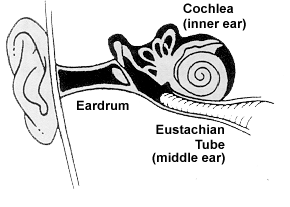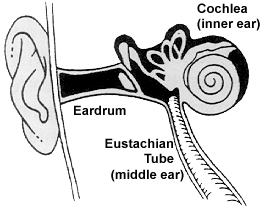Every year, over 10 million children in the United States are treated for ear infections. Chances are that by the time a child reaches the age of six, he will have suffered otitis media, an infection of the middle ear. Ear infections are most common in children between the ages of six months and three years.
The ear is a complex structure that consists of three sections: the outer, middle, and inner ears. The outer ear is the part we see. It is the external canal that picks up the vibrations from sound and transmits them through the eardrum to the middle ear. The middle ear contains three small bones that take these vibrations into the inner ear, which contains the nerve endings that make hearing possible. The inner ear is also involved in maintaining balance.
The middle ear is connected to the nasal cavity and the throat by means of a I passageway called the eustachian tube. This allows excess secretions from the middle ear to drain away from the ear and into the nose and throat. If the eustachian tube is not draining properly, these secretions build up in the middle ear, with the result that pressure in the ear rises and the ear becomes painful and, often, infected.
Young children are more likely than others to develop middle ear infections because in infants, the eustachian tube is oriented more horizontally than vertically, making drainage more difficult than it is in older children. Fluids can collect and become blocked, creating an ideal environment for bacterial growth.
Most children outgrow ear infections as their bodies mature and the structure
of the inner ear changes. As a child grows, the eustachian tube begins to curve
downward, allowing fluids to drain more easily. When the eustachian tube develops
its characteristic mature curve, fluids drain readily and infections are less
of a problem. When fully mature, the eustachian tube has a pronounced downward angle
(see illustrations below)
Figure A: Infant
 Figure B: Older Child
Figure B: Older Child

Structure of the Ear: In infants, the eustachian tube extends almost horizontally from the middle ear to the nasal cavity and the throat. (figure A) As a child grows, the eustachian tube develops a downward curve. (figure B)
Ear infections are often a complication of a common cold or other upper respiratory infection, such as infection of the adenoids, tonsils, or sinuses. They are sometimes accompanied by coughing, runny nose, sore throat, and, occasionally, vomiting and diarrhea. Depending on the cause of the infection, a fever may be present.
A child who can talk will be quick to tell you, "My ear hurts!" Babies and toddlers will "tell" you by pulling or tugging on their ears, by rubbing or hitting their ears, or by fussing and crying. A young infant may simply be irritable or run a high fever for no apparent reason.
Another common symptom of ear infection, which your child may not have the words to express, is a feeling of fullness and pressure. This is caused by the excess fluid pushing against the eardrum. Your child may have a slight hearing loss in the affected ear. In most cases, this is temporary. However, if ear infection and hearing loss occur repeatedly, they can cause long-term problems. According to the American Academy of Pediatrics, recurring ear infections with hearing impairment may slow speech and learning development, even if there is no permanent hearing loss.